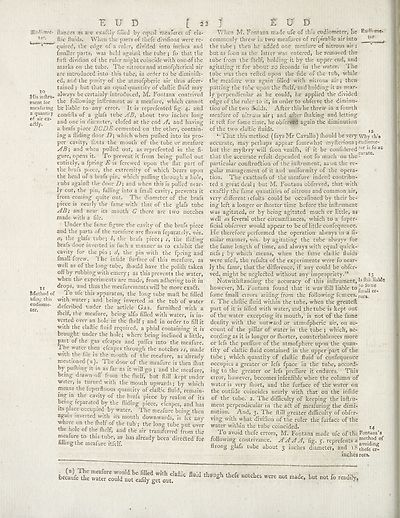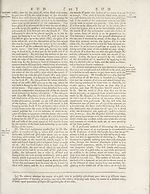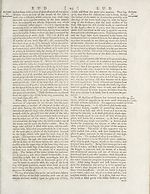Encyclopaedia Britannica > Volume 7, ETM-GOA
(34) Page 22
Download files
Complete book:
Individual page:
Thumbnail gallery: Grid view | List view

•His inftru-
-Tnent for
meal'uring
a quantity
cf air ex-
®<5Uy.
Method of
ufing this
eudiome-
E U D
fiances as are exa£lly/filled by equal meafures of ela-
ftic fluids. When the parts of thefe divifions were re¬
quired, the edge of a ruler, divided into inches and
fmaller parts, was held againit the tube ; fo that the
firft divifion of the ruler might coincide with one-df the
marks on the tube. The nitrous and atmofpherical air
are introduced into this tube, in order to be diminifli-
ed, and the purity of the atmofpheric air thus afeer-
tained ; but that an equal quantity of elaftic fluid may
always be certainly introduced, M. Fontana contrived
the following inflrument as a meafure, which cannot
be liable to any error. It is reprefented fig. 4. and
confifis ef a glafs tube about two inches long
and one in diameter, clofed at the end ^4, and having
a brafs piece ,Z?CZ).£ cemented on the other, contain¬
ing a Aiding door I); which when puflied into its pro¬
per cavity, flints the mouth of the tube or meafure
yff?; and wdien pulled out, as reprefented in the fi¬
gure, opens it. To prevent it from being pulled out
entirely, a fpring i? is ferewed upon the flat part of
the brafs piece, the extremity of which bears upon
the head of a brafs pin, which palling through a hole,
rubs againft the door Z); and when this is pulled near¬
ly out, the pin, falling into a fmall cavity, prevents it
from coming quite out. The diameter of the brafs
piece is nearly the fame with that of the glafs tube
AB; and 'near its mouth C there are two notches
made with a file.
Under the fame figure the cavity of the brafs piece
and the parts of the meafure are fliown feparately, viz.
a, the glafs tube; b, the brafs piece; c, the Aiding
brafs door inverted in fueh a manner as to exhibit the
cavity for the pin ; d, the pin with the fpring and
finall ferew. 1 he iniide furface of this meafure, as
Well as of the long tube, fhould have the poiifli taken
off by rubbing with emery; as this prevents the water,
when the experiments are made, from adhering to it in
drops, and thus the meafurements will be more exatfi.
To ufe this apparatus, the long tube muff be filled
with welter; and being inverted in the tub of water
deferibed under the article Gas, furnilhed with a
fhelf, the meafure, being alfo filled with water, is in¬
verted over an hole in the fhelf; and in order to fill it
with the elaftic fluid required, a phial containing it is
brought under the hole; where being inclined a little,
pait of the gas efcapes and paffes into the meafure.
The water then efcapes through the notches ss, made
with the file in the mouth of the meafure, as already
mentioned (b). The door of the meafure is then flmt
by pulhing it in as far as it will go ; and the meafure,
being drawn off from the fhelf, but Hill kept under
water, is turned with the mouth upwards; by which
means the fuperfluous quantity of elaftic fluid, remain¬
ing in the cavity of the brafs piece by reafon of its
being feparated by the Aiding piece, efcapes, and has
its place occupied by water. The meafure being then
again inverted with its mouth downwards, is fet any
where on the fhelf of the tub ; the long tube put over
the hole of the fhelf, and the air transferred from the
meafure to this tube, as has already been direded for
filling the meafure itfelf.
i J £' U; E)
When M. Fontana made ufe of this eudiometer, he En,,'<'rn5-
commonly threw in two meafiires of refpirable air into ,
the tube ; then he added one meafure of nitrous air :
but as foon as the latter was entered, he removed the
tube from the fhelf, holding it by the upper end, and
agitating it for about 20 feconds in the water. The
tube was then refted upon the fide of the tub, while
the meafure was again filled with nitrous air; then
putting- the tube upon the fhelf,- and holding it as near¬
ly perpendicular as he could, he applied the divided
edge of the ruler to it, in order to obferve the diminu¬
tion of the two fkiids. After this he threw in a fourth
meafure of nitrous air ; and after fhaking and letting
it reft for fome time, he obfet4cd again the diminution
of the two elaftic fluids. IZ
‘•That this method (fays Mr Cavallo) fhould be very why rh-’»
accurate, may perhaps appear fomewhat myfterious; eudiome- „
but the myftery will foon vanifh, if it be confidered
that the accurate refult depended not fo much on the •
particular conftruftion of the inftrument, as on the re¬
gular management of it and uniformity of the opera¬
tion. The exa&nefs of the rneafure indeed contribu¬
ted a great deal; but M. Fontana obferved, that with
exa&ly the fame quantities of nitrous and common.air,
very different refults could be occafioned by their be¬
ing left a longer or fhorter time before the inftrument
was agitated, or by being agitated much or little, as
well as feveral other circumftances, which to a fuper-
ficial obferver would appear to be of little confequence.
He therefore performed the operation always in a fi-
milar manner, viz. by agitating the tube always for
the fame length of time, and always with equal quick-
riefs; by which means, when the fame elaftic fluids
were ufed, the refults of the experiments were fo near¬
ly the fame, that the difference, if any could be obfer¬
ved, might be negledted without any impropriety.” 13
Notwithftanding the accuracy of this inftrument, liable
however, M. Fontana found that it was itill liable to-S-
fome fmall errors atihng from the following fcmces.
1. The elaftic fluid within the tube, when the greateft
part of it is filled with water, and the tube is kept out
of the water excepting its mouth, is not of the fame
denfity with the outward or atmofpheric air, on ac¬
count of the pillar of water in the tube ; which, ac¬
cording as it is longer or ftiorter, counterbalances more
or lefs the preffure of the atmofphere upon the quan¬
tity of elaftic fluid contained in the upper part of the
tube ; which quantity of elaftic fluid of confequence
occupies a greater or lefs fpace in the tube, accord¬
ing to the greater or lefs preffure it endures. This
error, however, becomes infenfible when the column of
water is very fliort, and the furface of the water on
the outiide coincides nearly with that on the infide
of the tube. 2. The difficulty of keeping the inffru-
ment perpendicular in the att of meafuring the dimi¬
nution. And, 3. The ftill greater difficulty of obfer-
ving with what divifion of the ruler the furface of the
water within the tube coincided. 14
I o avoid thefe errors, M. Fontana made ufe of the Fontana’*
following contrivance. A A A A, fig. 5. reprefents amet.^od ^
ihong glafs tube about 3 inches diameter, and i 8 ^efe er-
inches rors.
becaufe the water coul^Ifot^eafil^gaout.13^^ ^ thoUsh thefe n0tches were not made» but not fo readily,
-Tnent for
meal'uring
a quantity
cf air ex-
®<5Uy.
Method of
ufing this
eudiome-
E U D
fiances as are exa£lly/filled by equal meafures of ela-
ftic fluids. When the parts of thefe divifions were re¬
quired, the edge of a ruler, divided into inches and
fmaller parts, was held againit the tube ; fo that the
firft divifion of the ruler might coincide with one-df the
marks on the tube. The nitrous and atmofpherical air
are introduced into this tube, in order to be diminifli-
ed, and the purity of the atmofpheric air thus afeer-
tained ; but that an equal quantity of elaftic fluid may
always be certainly introduced, M. Fontana contrived
the following inflrument as a meafure, which cannot
be liable to any error. It is reprefented fig. 4. and
confifis ef a glafs tube about two inches long
and one in diameter, clofed at the end ^4, and having
a brafs piece ,Z?CZ).£ cemented on the other, contain¬
ing a Aiding door I); which when puflied into its pro¬
per cavity, flints the mouth of the tube or meafure
yff?; and wdien pulled out, as reprefented in the fi¬
gure, opens it. To prevent it from being pulled out
entirely, a fpring i? is ferewed upon the flat part of
the brafs piece, the extremity of which bears upon
the head of a brafs pin, which palling through a hole,
rubs againft the door Z); and when this is pulled near¬
ly out, the pin, falling into a fmall cavity, prevents it
from coming quite out. The diameter of the brafs
piece is nearly the fame with that of the glafs tube
AB; and 'near its mouth C there are two notches
made with a file.
Under the fame figure the cavity of the brafs piece
and the parts of the meafure are fliown feparately, viz.
a, the glafs tube; b, the brafs piece; c, the Aiding
brafs door inverted in fueh a manner as to exhibit the
cavity for the pin ; d, the pin with the fpring and
finall ferew. 1 he iniide furface of this meafure, as
Well as of the long tube, fhould have the poiifli taken
off by rubbing with emery; as this prevents the water,
when the experiments are made, from adhering to it in
drops, and thus the meafurements will be more exatfi.
To ufe this apparatus, the long tube muff be filled
with welter; and being inverted in the tub of water
deferibed under the article Gas, furnilhed with a
fhelf, the meafure, being alfo filled with water, is in¬
verted over an hole in the fhelf; and in order to fill it
with the elaftic fluid required, a phial containing it is
brought under the hole; where being inclined a little,
pait of the gas efcapes and paffes into the meafure.
The water then efcapes through the notches ss, made
with the file in the mouth of the meafure, as already
mentioned (b). The door of the meafure is then flmt
by pulhing it in as far as it will go ; and the meafure,
being drawn off from the fhelf, but Hill kept under
water, is turned with the mouth upwards; by which
means the fuperfluous quantity of elaftic fluid, remain¬
ing in the cavity of the brafs piece by reafon of its
being feparated by the Aiding piece, efcapes, and has
its place occupied by water. The meafure being then
again inverted with its mouth downwards, is fet any
where on the fhelf of the tub ; the long tube put over
the hole of the fhelf, and the air transferred from the
meafure to this tube, as has already been direded for
filling the meafure itfelf.
i J £' U; E)
When M. Fontana made ufe of this eudiometer, he En,,'<'rn5-
commonly threw in two meafiires of refpirable air into ,
the tube ; then he added one meafure of nitrous air :
but as foon as the latter was entered, he removed the
tube from the fhelf, holding it by the upper end, and
agitating it for about 20 feconds in the water. The
tube was then refted upon the fide of the tub, while
the meafure was again filled with nitrous air; then
putting- the tube upon the fhelf,- and holding it as near¬
ly perpendicular as he could, he applied the divided
edge of the ruler to it, in order to obferve the diminu¬
tion of the two fkiids. After this he threw in a fourth
meafure of nitrous air ; and after fhaking and letting
it reft for fome time, he obfet4cd again the diminution
of the two elaftic fluids. IZ
‘•That this method (fays Mr Cavallo) fhould be very why rh-’»
accurate, may perhaps appear fomewhat myfterious; eudiome- „
but the myftery will foon vanifh, if it be confidered
that the accurate refult depended not fo much on the •
particular conftruftion of the inftrument, as on the re¬
gular management of it and uniformity of the opera¬
tion. The exa&nefs of the rneafure indeed contribu¬
ted a great deal; but M. Fontana obferved, that with
exa&ly the fame quantities of nitrous and common.air,
very different refults could be occafioned by their be¬
ing left a longer or fhorter time before the inftrument
was agitated, or by being agitated much or little, as
well as feveral other circumftances, which to a fuper-
ficial obferver would appear to be of little confequence.
He therefore performed the operation always in a fi-
milar manner, viz. by agitating the tube always for
the fame length of time, and always with equal quick-
riefs; by which means, when the fame elaftic fluids
were ufed, the refults of the experiments were fo near¬
ly the fame, that the difference, if any could be obfer¬
ved, might be negledted without any impropriety.” 13
Notwithftanding the accuracy of this inftrument, liable
however, M. Fontana found that it was itill liable to-S-
fome fmall errors atihng from the following fcmces.
1. The elaftic fluid within the tube, when the greateft
part of it is filled with water, and the tube is kept out
of the water excepting its mouth, is not of the fame
denfity with the outward or atmofpheric air, on ac¬
count of the pillar of water in the tube ; which, ac¬
cording as it is longer or ftiorter, counterbalances more
or lefs the preffure of the atmofphere upon the quan¬
tity of elaftic fluid contained in the upper part of the
tube ; which quantity of elaftic fluid of confequence
occupies a greater or lefs fpace in the tube, accord¬
ing to the greater or lefs preffure it endures. This
error, however, becomes infenfible when the column of
water is very fliort, and the furface of the water on
the outiide coincides nearly with that on the infide
of the tube. 2. The difficulty of keeping the inffru-
ment perpendicular in the att of meafuring the dimi¬
nution. And, 3. The ftill greater difficulty of obfer-
ving with what divifion of the ruler the furface of the
water within the tube coincided. 14
I o avoid thefe errors, M. Fontana made ufe of the Fontana’*
following contrivance. A A A A, fig. 5. reprefents amet.^od ^
ihong glafs tube about 3 inches diameter, and i 8 ^efe er-
inches rors.
becaufe the water coul^Ifot^eafil^gaout.13^^ ^ thoUsh thefe n0tches were not made» but not fo readily,
Set display mode to:
![]() Universal Viewer |
Universal Viewer | ![]() Mirador |
Large image | Transcription
Mirador |
Large image | Transcription
Images and transcriptions on this page, including medium image downloads, may be used under the Creative Commons Attribution 4.0 International Licence unless otherwise stated. ![]()
| Encyclopaedia Britannica > Encyclopaedia Britannica > Volume 7, ETM-GOA > (34) Page 22 |
|---|
| Permanent URL | https://digital.nls.uk/189121671 |
|---|
| Attribution and copyright: |
|
|---|
| Description | Ten editions of 'Encyclopaedia Britannica', issued from 1768-1903, in 231 volumes. Originally issued in 100 weekly parts (3 volumes) between 1768 and 1771 by publishers: Colin Macfarquhar and Andrew Bell (Edinburgh); editor: William Smellie: engraver: Andrew Bell. Expanded editions in the 19th century featured more volumes and contributions from leading experts in their fields. Managed and published in Edinburgh up to the 9th edition (25 volumes, from 1875-1889); the 10th edition (1902-1903) re-issued the 9th edition, with 11 supplementary volumes. |
|---|---|
| Additional NLS resources: |
|

